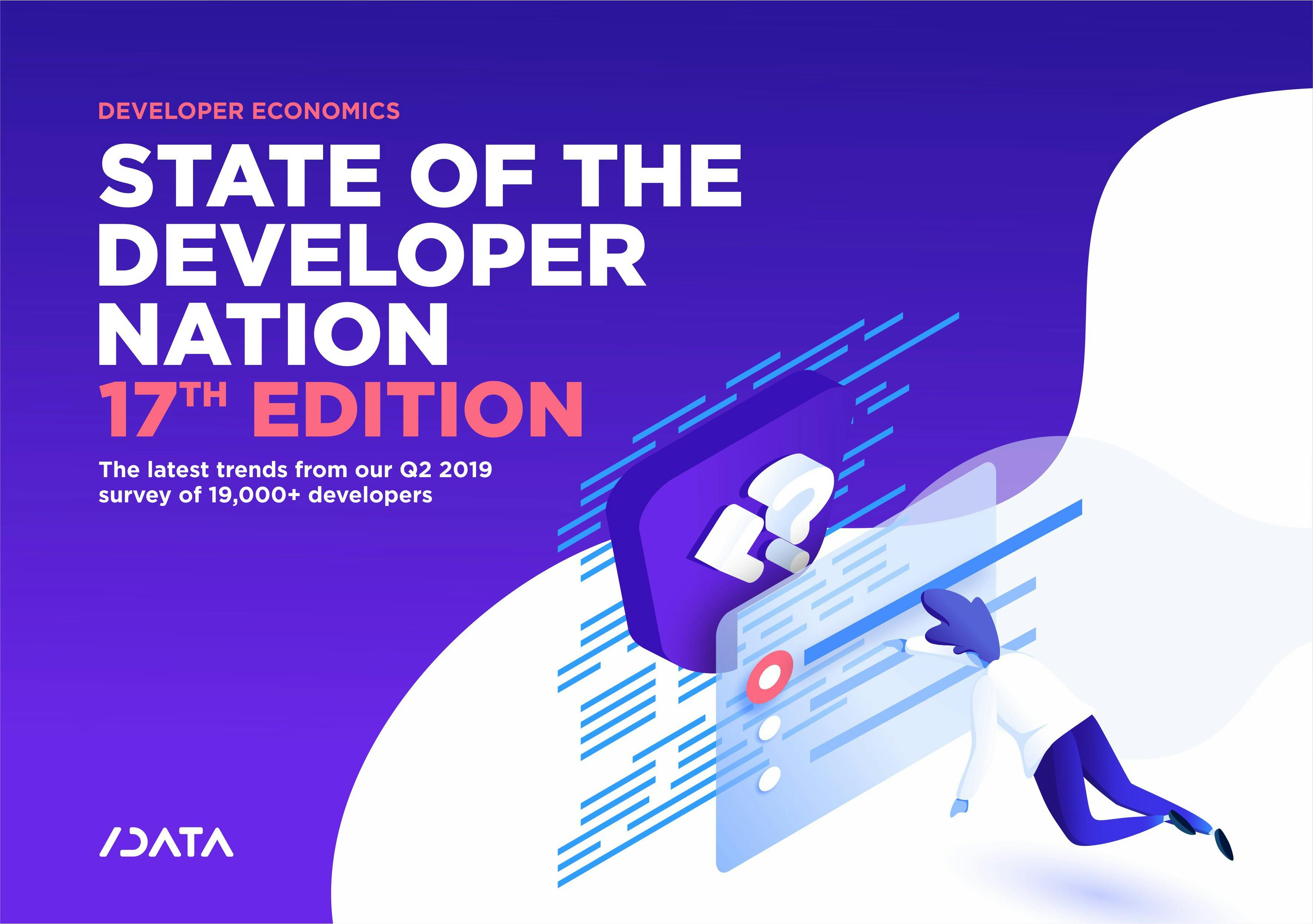
October 22, 2019
State of the Developer Nation 17th Edition - Q2 2019
The latest trends from our Q2 2019 survey of 17,000+ developers.
SlashData's Developer Economics is the leading research programme on mobile, desktop, IoT, cloud, web, game, augmented and virtual
reality, and machine learning developers as well as data scientists, tracking the developer experience across platforms, revenues, apps,
languages, tools, APIs, segments and regions.
The 17th Developer Economics global survey wave ran from June 2019 to August 2019 and reached more than 17,000 developers in 155 countries. This research report delves into key developer trends for H2 2019 and beyond.
The report focuses on six major themes - each with its own visualisations, showing how the data lends insight into the developer community.
1. Developer psychographics: How do developers perceive themselves? To discover more about developers across the globe, we asked them to choose words that built us a word sketch to describe them. In this chapter, we introduce software developers in their own words.
2. Programming language communities - an update: Programming languages are often the kernels of strong communities and the subject of opinionated debate. In this chapter we provide updated estimates of the number of active software developers using each of the major programming languages, across the globe and across all kinds of programmers.
3. Emerging Technologies: Interest in new technology ebbs and flows as the environment changes. In this chapter we look at how interest in emerging technologies changed over a 12 month period. We also look at what percent of developers that are interested in a technology are actually using it.
4. Game Streaming: Do game developers design for live-streaming? Gameplay streaming is a huge business opportunity, moving significant amounts of capital into the digital games ecosystem. But are developers actively designing their games to encourage it? What are the factors that influence developers' support for streaming? We report on the hardware platforms targeted by developers that most encourage streaming, and uncover the category of games they are building.
5. Third party platforms and ecosystems: Many platforms or ecosystems are trying to reproduce what Apple iOS and Google Android managed to do for the smartphone market by creating network effects between users and third-party developers. In this chapter we explore who the app developers for third-party platforms are, what are their motivations, their level of experience and which other sectors are they involved in.
6. Mobile cross-platforms frameworks: Mobile cross-platform frameworks help developers hit their targets, but how popular are they among developers? Do they like the abstraction that allows them to target multiple devices with different capabilities? Or is the compromise in performance and user experience too much of a stretch? We report on the uptake of different, popular frameworks and determine if the primary target platform and application category impacts a developer's preferences.
Methodology
Developer Economics 17th edition reached 17,000+ respondents from 155 countries around the world. As such, the Developer Economics series continues to be the most global independent research on mobile, desktop, IoT, cloud, web, game, AR/VR and machine learning developers and data scientists combined ever conducted. The report is based on a large-scale online developer survey designed, produced and carried out by SlashData over a period of eight weeks between June 2019 and August 2019.
Respondents to the online survey came from 155 countries, including major app, machine learning and IoT development hotspots such as the US, China, India, Israel, UK and Russia and stretching all the way to Kenya, Brazil and Jordan. The geographic reach of this survey is truly reflective of the global scale of the developer economy. The online survey was translated into eight languages in addition to English (simplified Chinese, traditional Chinese, Spanish, Portuguese, Vietnamese, Russian, Japanese, Korean) and promoted by more than 70 leading community and media partners within the software development industry.
To eliminate the effect of regional sampling biases, we weighted the regional distribution across eight regions by a factor that was determined by the regional distribution and growth trends identified in our Developer Economy research. Each of the separate branches: mobile, desktop, IoT, cloud, web,games, augmented and virtual reality, and data science and machine learning were weighted independently and then combined.
To minimise other important sampling biases across our outreach channels, we weighted the responses to derive a representative distribution for platforms, segments and types of IoT project. Using ensemble modeling methods, we derived a weighted distribution based on data from independent, representative channels, excluding the channels of our research partners to eliminate sampling bias due to respondents recruited via these channels. Again, this was performed separately for each of mobile, IoT, desktop, cloud, web, games, augmented and virtual reality, and data science and machine learning.
Contact us
Swan Buildings (1st floor)20 Swan StreetManchester, M4 5JW+441612400603community@developernation.net